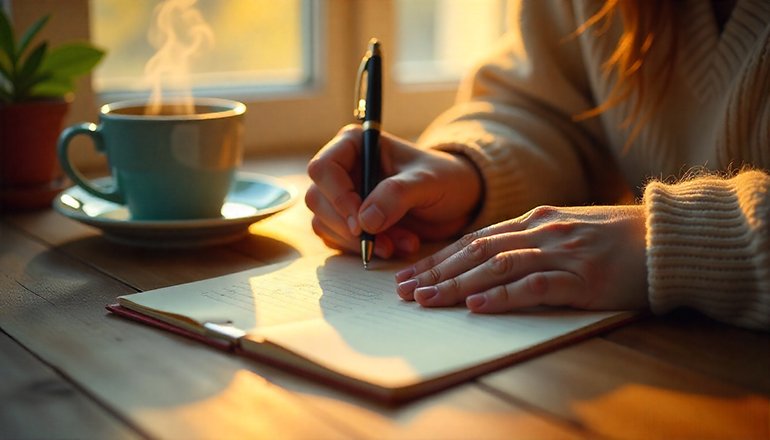
- comelyweb@gmail.com
- Compose Informal Letters
- August 26, 2025
- No Comments
Writing Informal Letters: A Timeless Guide
Table of Contents
ToggleThe Lost Art of the Informal Letter: A Guide to Writing with Heart and Touch
Remember the feeling of finding a handwritten letter in your mailbox? Not a bill, not a flyer, but a real, solid envelope with your name written in familiar handwriting. In an age of instant messaging, emails that demand immediate responses, and social media updates that disappear within 24 hours, the informal letter stands as a beautiful, enduring symbol of personal connection. It’s a slow, deliberate thought process that says, “I care enough about you to sit down, collect your thoughts, and put them on a page just for you.”
While there’s no hard-and-fast rulebook for writing to a friend or loved one, a little structure can turn a harshly worded note into a sweet memory. This guide is not about strict formulas. It’s about rediscovering the joy of personal correspondence and understanding the simple, timeless form that makes an informal letter so special. Let’s live this beautiful tradition.
What exactly is an informal letter?
An informal letter, often called a personal or friendly letter, is a written form of communication sent to people with whom you have a close personal relationship. Think of friends, family members, close cousins, former classmates, or pen pals. A key defining feature is its tone – free from the formality of business or official communication.
Unlike a formal letter, which has a specific purpose (such as a job application or complaint), the purpose of an informal letter is communication. It’s about sharing life updates, expressing feelings, offering support or just saying “I’m thinking of you.” It’s a snapshot of your life and your relationship with the recipient, preserved on paper.
Basic Components of an Informal Letter
Although you have a lot of freedom in what you say, most informal letters follow a familiar structure. This structure serves as a comfortable framework, guiding both writer and reader through the conversation.
1. Your Address (Sender’s Address)
Purpose: It tells the recipient where the letter is coming from. This is especially important if you expect a reply by mail.
Where does it go: in the upper right corner of the page.
How to write it: Your name is not required here, just your address. You can write it in a few simple lines:
text
Copy
Download
[your street address]
[Your City, State, Zip Code]
[date]
For a tip: In the digital age, if you’re sure you’ll only communicate via email or phone later, you can leave your address. But it includes a beautiful, traditional touch.
2. History
Purpose: This indicates the date when you wrote the letter. Years later, this small detail will provide wonderful context, connecting your words to a specific moment in time.
Where does it go: Just below your address, still to the right. You can also place it left or centered, but bottom-right alignment of the page is standard.
How to write it: You can write it in full (for example, 26 August 2023) or more simply (26/08/2023 or 26/08/2023). Month spells are often clearer and feel more personal.
3. hello (or hello)
Purpose: This is your friendly “Hello!” This sets the tone for the entire letter.
Where does it go: On the left side of the page, after the line space below the date.
How to write it: This is where your relationship shines. Common greetings include:
- Dear [first name], (The most classic and versatile choice)
- Dear [first name], (For very close family or romantic partner)
- Hello [first name], (a little more comfortable)
- Hello [nickname], (Most comfortable and modern)
- To my favorite cousin, (A fun, personalized option)
Always follow the greeting with a comma (,) and then start the body of your letter on a new line.
4. Opening paragraph
Purpose: To break the ice and establish a reason for writing. It’s “How are you?” It is like a conversation.
How to write it: Start by asking about the recipient’s well-being or referring to their last conversation.
- “I hope this letter finds you happy and healthy.”
- “Your letter last week was very good; I have been thinking of what you said . . .”
- “I’m just sitting here with a cup of coffee and realizing it’s been a long time since we caught up.”
Keep it attractive. This paragraph should make the reader feel appreciated and valued.
5. Body of the letter
Purpose: This is the heart of the matter. This is where you share your news, stories, thoughts and feelings.
How to write it: This is the most free-form section. No rules, just suggestions:
- Tell a story: Describe something that happened to you recently. Use vivid language to paint a picture.
- Share news: Talk about work, family, hobbies, or your travels.
- Ask questions: A letter should feel like a conversation. Ask about their lives, their opinions and their plans. It also makes it easier for them to write back.
- Be authentic: Don’t just list events. Share your feelings. Are you excited, nervous,
- Feeling nostalgic? That’s what makes a letter compelling.
- Use paragraphs: Break large blocks of text into smaller paragraphs, each focusing on a different topic. It makes reading much easier and more enjoyable.
6. Concluding paragraph
Purpose: To end the conversation, summarize your feelings, and signal that the letter is ending.
How to write it: This should be a natural consequence of your thoughts.
- “Well, I should probably let you go now. I can’t wait to hear all about your new project!”
- “Anyway, that’s all my news for now. Please give my love to your family.”
- “I’ll think about you next week. Good luck with your offer!”
- “Write back when you have a moment – no rush, I love hearing from you.”
7. Honorary Clause
Purpose: A polite and friendly way to say “goodbye”.
Where does it go: On the right side of the page, after the concluding paragraph.
How to write it: Choose a stanza that matches the tone of your relationship. Always follow it with a comma.
- Warmly, (A safe, friendly choice)
- best, / all good, (very common and hot)
- yours, / truly yours, (a bit more formal but still friendly)
- love, (For immediate family and friends)
- with love, / lots of love, (For very close relationships)
- Well done, (comfortable and modern)
- talk soon, (calm and optimistic)
8. Your signature
Purpose: To personally sign the letter.
Where does it go: directly below the definition clause.
How to write it: Sign your name by hand in ink. This is the most personal touch. If your handwriting is difficult to read, you can type or print your first name (or full name) below your signature.
9. Postscript (PS)
Purpose: To add an afterthought, a funny joke, or something you forgot to mention. This is a classic and charming feature of personal letters.
Where does it go: Right at the bottom of the letter, after your signature.
How to write it: Just write PS after your extra thought. You can also add one. PPS (after the postscript) if you have other ideas!
Formatting in the Digital Age: Emails and DMs
The spirit of the informal letter lives on in our digital communications. The same principles of heat and composition apply:
- Email Subject Line: Be specific and friendly. Instead of “hey,” say “trying to catch a rainy afternoon in Seattle” or “some thoughts after our call.”
- Hello: “Hello Sarah,” is perfect.
- Use all the same tips! Tell stories, ask questions, and use paragraphs. Emojis can help convey tone.
- Closing: “Best,” “Cheers,” or “Thanks” after your name.
- Signature: You can create a simple email signature with your name and maybe your phone number.
Even a long, thoughtful text message can follow this pattern. The medium changes, but the desire for real connection remains.
The Unwritten Rule: It’s all about the tone.
Format is the skeleton, but tone is the soul of your letter. Here’s how to nail it:
- Write the words like: Read your sentences aloud. Do they sound like you? If they feel tight, loosen them. Use contractions (can’t, won’t, it’s) to make more conversation.
- Be specific: Instead of “work has been busy,” try “We’re starting a new project this month, and I’ve been spending hours on these detailed designs—it’s stressful, but I’m excited about it.”
- Show, don’t just tell: Instead of “I had a nice walk,” explain it. “I went for a walk in the park yesterday. The leaves are just starting to turn red from this beautiful fire, and I saw ten squirrels gathering nuts for the winter. It made me think of my fall trip in college.”
Beyond the Basics: Making Your Letter Extra Special
Want to go the extra mile? Here are some ideas:
- Stationary: Use fun, personalized stationery or even just nice, thick paper. This experience makes both you and the recipient feel special.
- Pen: Write in a color other than blue or black. A dark green or purple pen can feel unique and personal.
- Attachments: A photo, a pressed flower from your garden, your favorite recipe, or your child’s drawing.
- Decoration: Doodle in the margin! Add small drawings that relate to your stories.
Frequently Asked Questions (FAQ)
Question: How long should an informal letter be?
A: There is no required length! It can be a short, one-page note just to say hello, or a long, multi-page epic. The correct length is what you want to say. A sincere short letter is always better than no letter at all.
Q: Can I type and print an informal letter?
A: Absolutely. Although handwriting is favored for its personal touch, a typed letter is perfectly acceptable, especially if your handwriting is difficult to read. Thought and effort count the most. If you type it out, leave a little space to add a quick handwritten note like “Miss you!” Or signing your name in ink can add that personal element.
Q: What if I don’t know what to write about?
A: Everyone feels that way sometimes! Start with the basics: What did you do today or this week? Describe a book you’re reading or a show you’re watching and what you think about it. Share a funny memory you thought of recently. Ask them for advice on something. Tell them about the food you cooked. Once you start, the words will often begin to flow.
Q: Is it okay to send an informal letter to someone I’m not very close to?
A: Yes, and it can be a surprisingly surprising gesture. A thank-you note for a dinner party, a letter to an old teacher who inspired you, or a note to a relative you don’t see often can be incredibly meaningful. Just adjust the tone so that you are a little more polite and reserved than a best friend.
Question: How is an informal letter different from a formal letter?
A: The differences are significant. Informal letters use a personal tone, contractions, casual language, and a simple structure that focuses on connection. Formal letters use a professional tone, avoid contractions, use formal language (for example, “I’m writing to inquire…”), and have a strict format that includes the recipient’s formal address, subject line, and specific formal clauses such as “Sincerely.”
Conclusion: It’s your turn to write.
In a world that moves at a fast pace, an informal letter is a gentle reminder. It is a conscious choice to slow down, reflect and connect on a deeper level than temporal notice allows. It is a tangible piece of love, friendship, and history that can be held in one’s hand, stored in a box, and rediscovered years later, bringing back a flood of memories with astonishing clarity.
You don’t need a special occasion. All you need is a piece of paper, a pen, and a person you want to talk to. So, think of someone who would love to hear from you. Remember the simple form: your address, the date, a warm greeting, your news, a kind closing, and your signature. Then let your heart do the rest. Not only can you rediscover the art of letter writing, but also the joy of conversation that unfolds slowly, sweetly, and meaningfully one handwritten word at a time.





